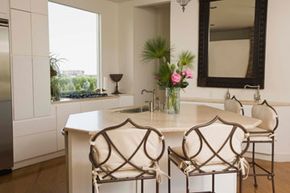When you're selling a house, you have about six seconds to make a positive impression on potential buyers. According to Professional Builders magazine, that's all the time it takes for people to decide whether they'd like to purchase your home. That means you can't rely on a stunning interior to make up for a poorly manicured lawn, or a prim bed of begonias to distract attention from peeling paint. Instead, prepping a home for sale requires attending to all maintenance and dècor details to create an attractive, cohesive presentation.
This process of converting a lived-in home into a show-worthy house is called home staging. Not to be confused with redecorating, home staging transforms the highly personalized elements of a house into an appealing blank canvas. A properly staged home should feel warm and inviting, but not worn in. As a result, a listing has a better chance of selling faster for a higher price.
Advertisement
Home staging isn't a one-size-fits-all process -- some places will require more of a face-lift than others. But the following five do's and don'ts apply to any staging project.
